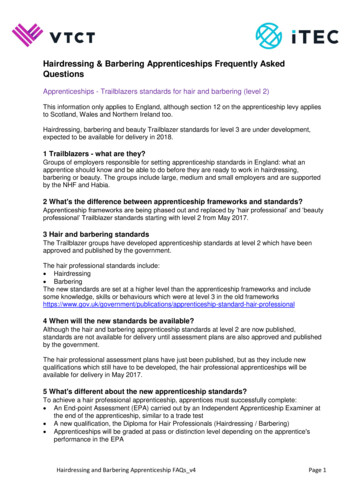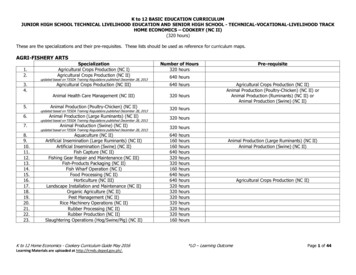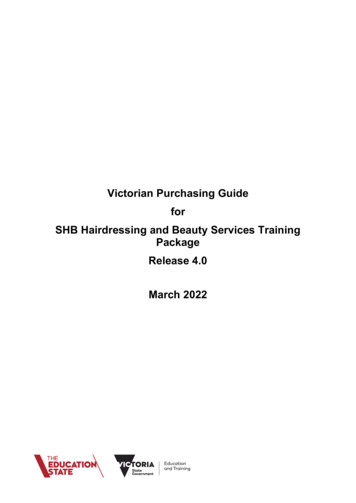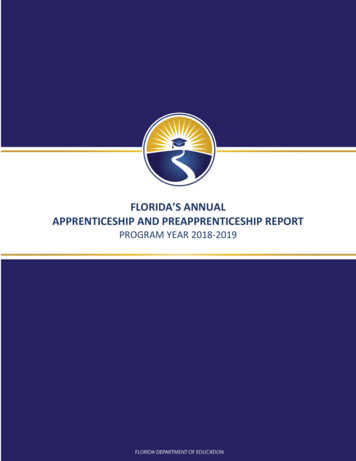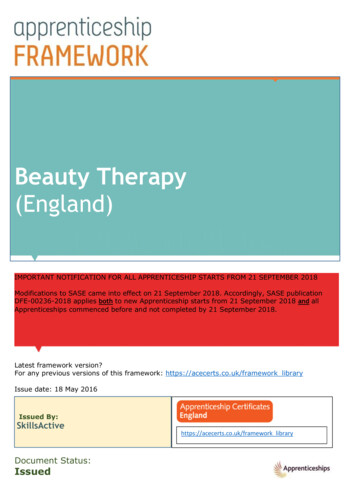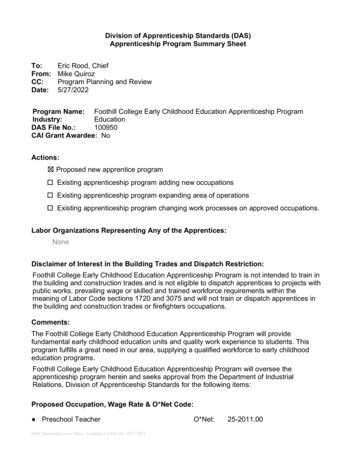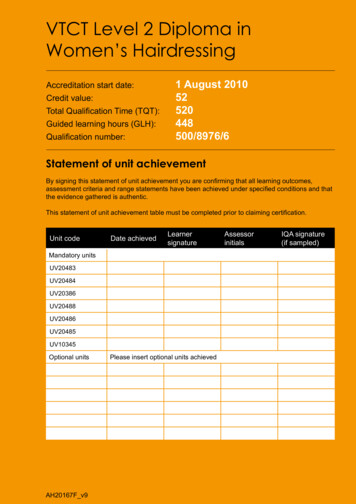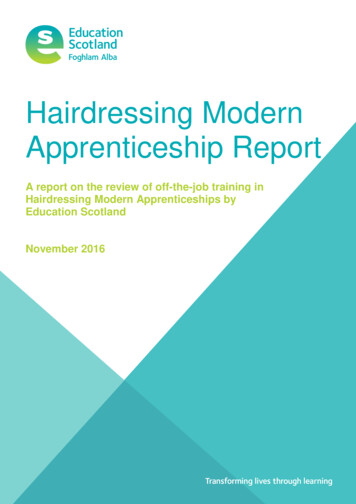
Transcription
Hairdressing ModernApprenticeship ReportA report on the review of off-the-job training inHairdressing Modern Apprenticeships byEducation ScotlandNovember 2016
ContentsPage Number1. Context42. External Review Methodology53. The National Report74. Grades75. Findings86. The Review of Hairdressing MAs87. Summary of Findings88. 1. Outcomes and impact108.1. 10How well are our apprentices progressing and achieving relevant highquality outcomes?8.1.1. How effective is the centre at achieving and maintaining high10levels of service delivery?8.1.2. How well do centres adhere to statutory principles and10guidance?8.2. How well do we meet the needs of our apprentices and stakeholders?118.2.1. 11How well are apprentices progressing and achieving relevanthigh quality outcomes?8.2.2. How well does training meet the need of apprentices and13employers?9. 2. Delivery of Training149.1. How good is our delivery of training?149.1.1. 14How well does training meet the needs of apprentices andemployers?9.1.2. How well is training delivered?159.1.3. How well do staff reflect on provision to improve training?169.1.4. How well do employers and apprentices participate in the17development and planning of training?2 Hairdressing Modern Apprenticeship Report
9.2. How good is our management of training delivery?189.2.1. 18How well does the centre work with partners to improveoutcomes for apprentices?10. 3. Leadership and Quality Culture10.1. How good is our strategic leadership?10.1.1. How effective is leadership for partnership working and191919delivery of training?10.1.2. How well do leaders secure improvements in the quality and19impact of training?11. 4. Capacity for Improvement11.1. How good is our capacity to improve?11.1.1. How good are our internal evaluation and self-reflection212121activities to ensure we have the capacity to improve and enhance ourprovision and delivery?12. Recommendations2313. Appendices24Appendix 1 Grade Illustrations24Appendix 2 Glossary of Terms253 Hairdressing Modern Apprenticeship Report
ContextThe UK hair and beauty sector has a turnover of over 6 billion per year. This sector employsnearly a quarter of a million people, and makes a contribution of around 1% to the UKeconomy.1 The latest statistics from Habia (Hair and Beauty Industry Authority) show that 8% ofthe hair and beauty sector is based in Scotland, providing around 0.5 billion per year to theScottish economy. However, UK statistics also show that 20% of hair salons have vacancies,which equates to around 4000 job opportunities across Scotland. According to Habia, 1500 ofthese vacancies are unfilled due to the poor quality of applicants coming learly there are many employment opportunities available in the Scottish hairdressing sector.To ensure a trained workforce, Modern Apprenticeships (MAs) are designed to supportindividuals with career aspirations to gain industry recognised qualifications while earning awage. A MA may be a new or an existing employee who is seeking to increase their capabilityor qualifications. As such, apprentices are entitled to receive training that matches the businessneeds of employers.MA opportunities are available across a wide range of industry sectors and each sector has aset of occupational standards. National Occupational Standards (NOS)2 are statements of thestandards of performance that individuals must achieve when carrying out functions in theworkplace, together with specifications of the necessary underpinning knowledge andunderstanding. NOS are developed for employers by employers, through the relevant SectorSkills Council (SSCs) or Standards Setting Organisation (SSOs) who are recognised by the UKCommission for Employment and Skills (UKCES). SkillsActive3 is responsible for the NOSacross the Active Leisure, Learning and Well-being sector. Through their license with UKCES,SkillsActive manage the Hair and Beauty NOS in partnership with Habia. These are thestandards considered in this review4.2http://nos.ukces.org.uk/Pages/index.aspx www.habia.org/3Education Scotland have been commissioned by the Scottish Government to undertake externalreviews of the off-the-job training element of MA programmes within each of the industry sectorsover the coming years.The strategic vision outlined by the Scottish Government in Scotland’s Youth EmploymentStrategy (YES) is for a post-16 education and training sector in which: all provision, regardless of provider, is focused on providing young people with the skills,knowledge and attributes necessary to support Scotland’s economic growth andmaximise their life chances;all providers and their key stakeholders work together regionally and nationally to ensurehigh quality provision that meets the needs of learners and employers; andthe relevance and quality of this provision, the extent to which it supports economicgrowth and post-16 reform, and the outcomes learners achieve are evaluated through anappropriate blend of self-evaluation, external scrutiny and public reporting through anational quality assurance and quality improvement system.4 Hairdressing Modern Apprenticeship Report
External review methodologyEducation Scotland’s external review of the off-the-job training element of MAs builds upon andcomplements Skills Development Scotland’s (SDS) current quality assurance arrangements.These arrangements require all non-college training providers to demonstrate they are meetingSDS quality standards as set out in the SDS Quality Assurance Framework. SDS takesassurance of MA programme delivery from Education Scotland’s external review of colleges,which focus on the contribution made by training providers and the quality of the training theydeliver.A team of Her Majesty’s Inspectors (HMI) from Education Scotland and Associate Assessors(AA), from SDS, colleges and Independent Training Providers (ITP) conduct external reviews.Associate Assessor input ensures that each review team has the expert knowledge andindustry-related experience to ensure a full and well-informed review process. The review teamevaluated the work undertaken by a sample of colleges and ITPs, referred to collectively as‘centres’ in this report.External review approaches incorporate: Observation of training activities.Discussions held with centre managers and staff.Discussions held with employers and apprentices.Upon conclusion of the external review, a written report is provided to each centre by EducationScotland. This includes the grades awarded for each of the six high-level questions posedduring the review (see below). This report is shared with SDS but is not published externally,although centres may choose to share their individual reports after the main report is published.The findings from each of the visits are brought together to generate a national report which ispublished by Education Scotland on behalf of the Scottish Government. National reports aredesigned to inform Ministers about the quality of the off-the-job training element within specificMA programmes. The report will also assist providers in preparing and implementing theirquality improvement and enhancement agendas, and include examples of excellent practicewhere identified.For this review of hairdressing MAs, Education Scotland evaluated the provision of providers’off-the-job training in the following centres between January and May 2016: Fife College.First Happy Ltd (Rainbow Room International).Moray College UHI.North East Scotland College.Qualitas International Limited.The Academy of Hairdressing Excellence Ltd.West College Scotland.The Kramer Consultancy Ltd.Prior to commencing the centre visits, Education Scotland and SDS agreed that the revisedHairdressing and Barbering Scottish Vocational Qualification (SVQ) frameworks (approvedthrough Habia in September 2015) would be the focus of the reviews. Within the Habiaframework there are three levels of qualification for Hairdressing and Barbering, at SVQ Levels1, 2 and 3 of the Scottish Credit and Qualifications Framework (SCQF) Levels 4-6. Each levelincludes a core skills signposting matrix. For this review, Education Scotland evaluated the5 Hairdressing Modern Apprenticeship Report
delivery of the off-the-job training elements in Hairdressing and Barbering at SVQ Levels 2 and3 (SCQF levels 5 and 6) along with the relevant level of core skills.The report also uses the following terms to describenumbers and proportions:almost allmostmajorityless than halffew6 Hairdressing Modern Apprenticeship Reportover 90%75-90%50-74%15-49%up to 15%
The National ReportThe framework and model for this external review are based upon the quality elements from theNational Quality System, designed by Education Scotland, in collaboration with organisationssuch as the SQA, SDS, Scottish Government, and industry partners.The national report includes a grade for each of the questions within the four high levelprinciples. These high level principles are: Outcomes and Impact.Delivery of Training.Leadership and Quality Culture.Capacity for Improvement.Grades are awarded for the following six questions in the four high level principles:1. Outcomes and ImpactHow well are apprentices progressing and achieving relevant high quality outcomes?How well do we meet the needs of our apprentices, employers and stakeholders?2. Delivery of TrainingHow good is our delivery of training?How good is our management of training delivery?3. Leadership and Quality CultureHow good is our strategic leadership?4. Capacity to ImproveA capacity to improve judgment based on evidence from all key areas above, in particularOutcomes, Impact and Leadership.GradesThe following six-point scale is used to determine the individual grade awarded for each of thesix questions: EXCELLENT – Outstanding.VERY GOOD – Major Strengths.GOOD – Important strengths with some areas for improvement.SATISFACTORY - Strengths just outweigh weaknesses.WEAK – Important weaknesses.UNSATISFACTORY – Major weaknesses.Grade descriptors are provided in Appendix 1.7 Hairdressing Modern Apprenticeship Report
FindingsThe review of Hairdressing MAsInspectors observed learning and teaching and other important activities that impact upon thequality of the apprentice experience. These were evaluated against the four high-levelprinciples of Outcomes and Impact, Service Delivery, Leadership and Quality Culture andCapacity to Improve; using the 12 reference quality indicators outlined in Education Scotland’sExternal quality arrangements for the review of Modern Apprenticeship Off-the-job training eship/index.aspThe summary grades awarded for each of the six questions are presented below.1. Outcome and Impact2. Delivery of Training3. Leadership andQuality Culture4. Capacity forImprovementHow well areapprenticesprogressingand achievingrelevant highqualityoutcomes?How well do wemeet the needsof ourapprenticesandstakeholders?How goodis ourdelivery oftraining?How good isourmanagementof trainingdelivery?How good is ourstrategic leadership?How good areinternalevaluation andself-reflectionactivities toensure we havethe capacity toimprove andenhance thedelivery oftraining?goodgoodgoodgoodgoodgoodSummary of FindingsAreas of Strength All centres delivering MA provision ensure programmes achieve lead and awarding bodystandards through effective standardisation and verification meetings.The majority of centres offer flexible start dates and options for curriculum delivery thatsuit the needs of employers.Most centres use feedback from apprentices and employers effectively to improve thedelivery of training.Hairdressing competitions and apprentices’ successes are used well to inspire theprofessional ambitions of apprentices and raise their vocational skill levels.Most apprentices are enthusiastic about their training and motivated to succeed. Theyare satisfied with their apprenticeship training and with the progress they are making.Most teaching staff plan the delivery of training well and include a good balance of theoryand practical activities that apprentices find engaging.Almost all teaching staff have relevant, up-to-date experience and vocational knowledgethat is enhanced through their own part-time work as hairdressing professionals.Very good relationships exist between centre staff, this supports apprentices well andencourages achievement and progression.Most training salons are high quality and provide industry standard facilities, equipmentand products. A few salons promote sustainability in their design, equipment and8 Hairdressing Modern Apprenticeship Report
products that encourages apprentices to consider their environmental responsibilities andsupports government priorities.The majority of apprentices receive a high quality learning experience that develops theirhairdressing and employability skills effectively.The majority of employers are satisfied with the training provided and confirm it ismeeting their needs.Most teaching staff are highly committed and motivated to provide a positive experiencefor their apprentices.Most centres have productive links with employers and schools which take good accountof the local economic context.Managers in centres lead their teams well and there is a collegiate culture thatcontributes to effective team working.Most centres have effective self-evaluation arrangements in place to evaluate their MAprogrammes and to determine actions for improvement.Apprentice progress is tracked well and apprentices are aware of their progress andgoals.Most apprentices achieve their core skills units and these are contextualised well intoprogramme design and delivery.Teaching staff promote equality and diversity well during training sessions and usenaturally ocurring opportunites to stimulate discussion.Apprentices are involved in the planning of curriculum delivery and learning and teachingapproaches.Areas for Development In more than a few centres, attainment is below national performance levels.In some centres, low attendance prevents apprentices from progressing with theirstudies.More than a few centres do not recruit sufficient apprentices to meet their SDS contract.Strategic planning to embed government priorities for the post-16 education and trainingsector is not yet fully effective in all centres.The majority of centres do not analyse performance data sufficiently well to inform selfevaluation and improvement planning.The recruitment of male apprentices into the hairdressing profession remains a challengeand only a few initiatives, such as the barbering award, have made any impact on genderbalance.In more than a few centres, arrangements to engage with employers and to gather formalinput from apprentices are not sufficient to inform planning of delivery and programmecontent.More than a few centres do not engage effectively with their local employers, particularlyin relation to apprentice recruitment and employers’ responsibilities for supportingapprentice training.In a few centres, self-evaluation arrangements are insufficiently systematic and robustand planning for improvement is not fully effective.Access to Information and Communications Technology (ICT) for apprentices in a fewsalons is not sufficient and only a few salons have industry based software forapprentices to practice their ICT skills.Some Centres do not have effective arrangements to support apprentices with additionalsupport needs or appropriate referral to other agencies, and a few centres do not havesufficient access for individuals with a physical disability.Most centres have difficulty in finding sufficient hairdressing clients for apprentices topractice their skills and to complete their assessments.9 Hairdressing Modern Apprenticeship Report
1. Outcomes and ImpactHow well are apprentices progressing and achievingrelevant high quality outcomes?GRADE: goodHow effective is the centre at achieving and maintaining high levels of service delivery?The majority of centres visited are making good progress in achieving their organisationalpriorities and meeting SDS contract levels for MA hairdressing programmes. These centresmake good use of local labour market intelligence to create useful development plans thatreflect their wider strategic aims and Scottish Government priorities, including Developing theYoung Workforce (DYW). These plans incorporate targets to increase MA provision that arealigned well with the local economic context and national priorities for skills development.However, in some centres, aims and objectives for the achievement of high quality outcomesare vague, and apprentice recruitment is declining. In these centres, employer engagement isnot fully effective, which limits the scope to inform and influence plans, reflect on trainingdelivery or actively promote the benefits of MA programmes. Some Centres do notdisaggregate performance data for apprenticeship programmes to inform future plans andtargets. In a few centres, arrangements that inform future planning of the MA programme ispredicated on informal knowledge of the local employer network, rather than a detailed analysisof employer needs.In the majority of centres, achievement rates are high compared with national performancelevels for hairdressing MA programmes. In these centres, withdrawal rates are low and mostapprentices progress from the SVQ Level 2 to Level 3. However, in more than a few of thecentres visited, withdrawal rates are high and achievement rates are low. In a few centres, theattendance of apprentices is affected due to employers choosing to prioritise the staffing needsof their salon over off-the-job training. This impacts on the ability of individual apprentices tomake progress, and can lead to their early withdrawal from the MA programme.Most apprentices attain core skills units and are making good progress in developing theirconfidence and skills for life, learning and work. Most apprentices who complete their MAprogramme gain employment with local hairdressing salons.Almost all centres actively promote opportunities for under-represented groups, with a particularfocus on addressing the gender imbalance on MA programmes. Some centres have introduceda barbering qualification to increase opportunities for male apprentices to undertake a career inhairdressing. However, despite efforts to improve gender imbalance, the participation of maleapprentices on MA hairdressing programmes is low, at approximately 9%.How well do centres adhere to statutory principles and guidance?All centres ensure that MA programmes meet the required awarding body standards. Centrestaff hold regular standardisation meetings that are effective in ensuring consistency andcompliance with awarding body and lead body requirements. However, in a few colleges,teaching staff do not always ensure awarding body standards are delivered consistently acrossthe MA programme. All centres have a positive working relationship with SDS. This supportswell the monitoring of MA contractual requirements and progress towards implementation of anyidentified development points.10 Hairdressing Modern Apprenticeship Report
Most centres have appropriate arrangements in place to comply with health and safetylegislation. These include health and safety training that is relevant for practical activities in theworkplace and best practice that is promoted effectively by staff in the training salons.However, in a few centres, there is a need to reinforce salon policies and procedures for the useof Personal Protective Equipment (PPE) and clients’ skin testing.All centres recognise equality and diversity as a strategic priority. They use a variety ofmethods well, including social media, employer forums and school visits, to promoteopportunities for apprentices from a range of backgrounds and circumstances. Almost allcentres take good account of the individual needs of apprentices. However in a few centres,particularly ITPs, arrangements for apprentices and clients with physical disabilities to accesscentre facilities are insufficient.Almost all centres are members of the UK’s largest trade association for hairdressing, barberingand beauty salon owners, The National Hairdressers’ Federation (NHF). The NHF offer a rangeof useful Career Long Professional Learning (CLPL) opportunities through attendance at annualconferences and training events, which enable staff to maintain their professional knowledge ofindustry standards.At one centre, all hairdressing lecturers and managers are registered with The Hair Council,6who campaign to make regulation compulsory for all hairdressers, raise standards, andrecognise hairdressing as a profession. Registration endorses the expertise and training ofqualified hairdressers, provides clients with reassurance and allows them to make an informedchoice. Staff within the centre highlight the benefits of being registered with the Hair Council toapprentices and actively encourage them to apply on completion of their apprenticeship. Thecentre and the Hair Council contribute towards a voucher that is provided to successfulapprentices to assist them with the initial cost of their registration.6http://www.haircouncil.org.uk/How well do we meet the needs of our apprentices andstakeholders?GRADE: goodHow well are apprentices progressing and achieving relevant high quality outcomes?The majority of apprentices are making good progress and achieving relevant high qualityoutcomes. They develop confidence and skills which their employers recognise as valuable totheir business. Almost all apprentices make good progress with their core and essential skills,and those who require additional assistance are supported well to achieve the requirements fortheir award. However, in a few centres, apprentices do not have the opportunity to achieve incore skills subjects beyond the minimum requirements of the award.In most centres, the delivery of MA training is supporting apprentices to mature and gain thevocational skills required in their workplace. These MA programmes meet the needs ofemployers, local schools and apprentices well. Almost all employers prefer this blend of workbased training with day-release attendance at a training centre. Wherever possible, centresoffer additional activities to apprentices, which develop further their skills and knowledge acrossa wider range of topics. These include industry-led workshops for hair colouring, bridal hair,plaiting and weaving, razor cutting and vintage hair. All apprentices who participate in theseactivities value the additional experience and the skills they gain.11 Hairdressing Modern Apprenticeship Report
The majority of centres offer flexible attendance options to suit employers, including a choice ofstart date, fast-track routes, roll-on-roll-off intake, and attendance on a weekly, fortnightly ormonthly basis. A few centres also offer twilight practical sessions, which attract a wider varietyof clients and allow more time for apprentices to develop their range of practical skills.However, not all employers are made aware of the opportunities for flexible delivery,assessment in the work place or the availability of bespoke topics. A few centres offer only onestart date each year, which increases the challenge for the recruitment of apprentices.Most apprentices make good use of individual training plans to work independently towards theirtraining goals at their own pace. These training plans support effective tracking and review ofapprentice progress, which is shared with employers. Regular feedback to apprentices helps toensure a clear understanding of their progress and most apprentices recognise the progressthey are making.Almost all centres arrange in-house competitions and encourage apprentices to entertournaments for national hairdressing awards to help enhance their experience and buildconfidence. Many apprentices are successful in competitions and this is often celebratedthrough annual awards ceremonies, which motivate apprentices to achieve high standards andshare their success with employers, family and friends. Centres use these ceremonies well toshowcase MA programmes and to strengthen and extend employer links.Excellence ExampleNorth East Scotland College – North East Hair and Beauty FestivalNorth East Scotland College has hosted the North East Hair and Beauty Festival for thelast twelve years. The event is organised by the Hairdressing and Beauty Therapycurriculum teams to showcase the creativity of learners and apprentices, withaproximately three hundred entrants across a range of competitions, including eveninghairstyles, creative colours, manicures and fantasy make-up. All colleges located northof the central belt are invited to compete, along with hairdressing salons in the Aberdeencity and Aberdeenshire areas. The event also promotes collaboration with otherapprentices from North East Scotland College, in subject areas such as photography,multi-media and event planning, all of whom contribute to the organising and running ofthe event.To ensure the event has a professional atmosphere, experienced judges are invited fromthe National Hairdressers Federation, Association of Hairdressers and Therapists andfrom City and Guilds. Medals, certificates and prizes are presented to those who areplaced in the competition and a trophy is presented to the North East Trainee Hairdresserof the Year, North East Trainee Beauty Therapist of the year and Qualified Hairdresser ofthe Year.The competition provides learners and apprentices at all qualification levels with anopportunity to participate in a large hair and beauty hairdressing competition thatprepares them well for national tournaments. Participants are encouraged to competeagainst those at a higher level, which builds their confidence and provides opportunitiesto showcase their vocational skills. Local stylists also enter the Qualified Hairdressercategory, giving apprentices a realistic competition experience and employers attend tosupport their modern apprentices.12 Hairdressing Modern Apprenticeship Report
How well does training meet the needs of apprentices and employers?Almost all centres engage well with a range of partners to ensure that MA hairdressingprogrammes are relevant to the economy and local employers. All centres have effectivepartnership arrangements with SDS and most centres deliver activities to promote MAs toemployers, including national campaigns, such as Scottish Apprenticeship Week andpromotional activities such as a ‘100 MAs in 100 days’. All centres have good relationships withHabia and benefit from access to Habia resources that enhance the delivery of training and theapprentices’ experience. Many centres enrich the MA training experience by inviting localemployers, professional bodies and product/equipment suppliers to deliver talks anddemonstrations for apprentices. These opportunities support apprentices well to developrelevant knowledge and skills for employment.Most centres engage well with employers, either through a dedicated liaison team in the largercentres, or through work placement assessors. These arrangements enable strongcommunication links between employers and centres, ensuring that apprentice progress ismonitored and providing opportunities for centre staff to establish employer requirements.However, not all centres make employers fully aware of their roles and responsibilities inrecruiting apprentices and providing the necessary support for their off-the-job training.The majority of employers are positive about their engagement with centres and a few indicatea high level of satisfaction with the experience of their apprentices. They welcome theopportunities offered for training of apprentices and value the development of the knowledgeand understanding elements delivered by teaching staff, which they do not have the capacity orexpertise to deliver themselves. However, in more than a few centres, around half of theemployers are not satisfied with the delivery of training, have insufficient communication withthe centre and do not find centre staff responsive to their needs.The majority of apprentices are satisfied with their MA programme, enjoy their training andappreciate the support provided by centre staff. They are positive about the progress they aremaking and have aspirations to be successful hairdressers in the future. Many apprenticeswould recommend an MA programme to their family and friends.Most apprentices are able to influence what is delivered within their MA programme, such asresearching particular hair styles or learning new skills related to their own employmentcircumstances. Many have the opportunity to share their views with staff about their satisfactionwith their MA programme and suggest improvements to the training. Whenever practical,centres take apprentices’ interests and employer preferences into account to enhance the MAprogramme content. However, in more than a few centres, the views of apprentices andemployers are not systematically sought or analysed to ensure the context of delivery reflectscurrent industry practice.13 Hairdressing Modern Apprenticeship Report
2. Delivery of TrainingHow good is our delivery of training?GRADE: goodHow well does the design and delivery of training meet the needs of apprentices andemployers?Most centres offer a good range of professional qualifications for the hairdressing industryacross SCQF Levels 5 to 7. A few centres also offer specialisms such as a barbering. Almostall off-the-job training is relevant to the local and regional economy and provides a positivecontribution to raising the employability levels of hairdressing apprentices. Almost all
6 Hairdressing Modern Apprenticeship Report delivery of the off-the-job training elements in Hairdressing and Barbering at SVQ Levels 2 and 3 (SCQF levels 5 and 6) along with the relevant level of core skills. The report also uses the following terms to describe numbers and proportions: almost all over 90% most 75-90% majority 50-74%
